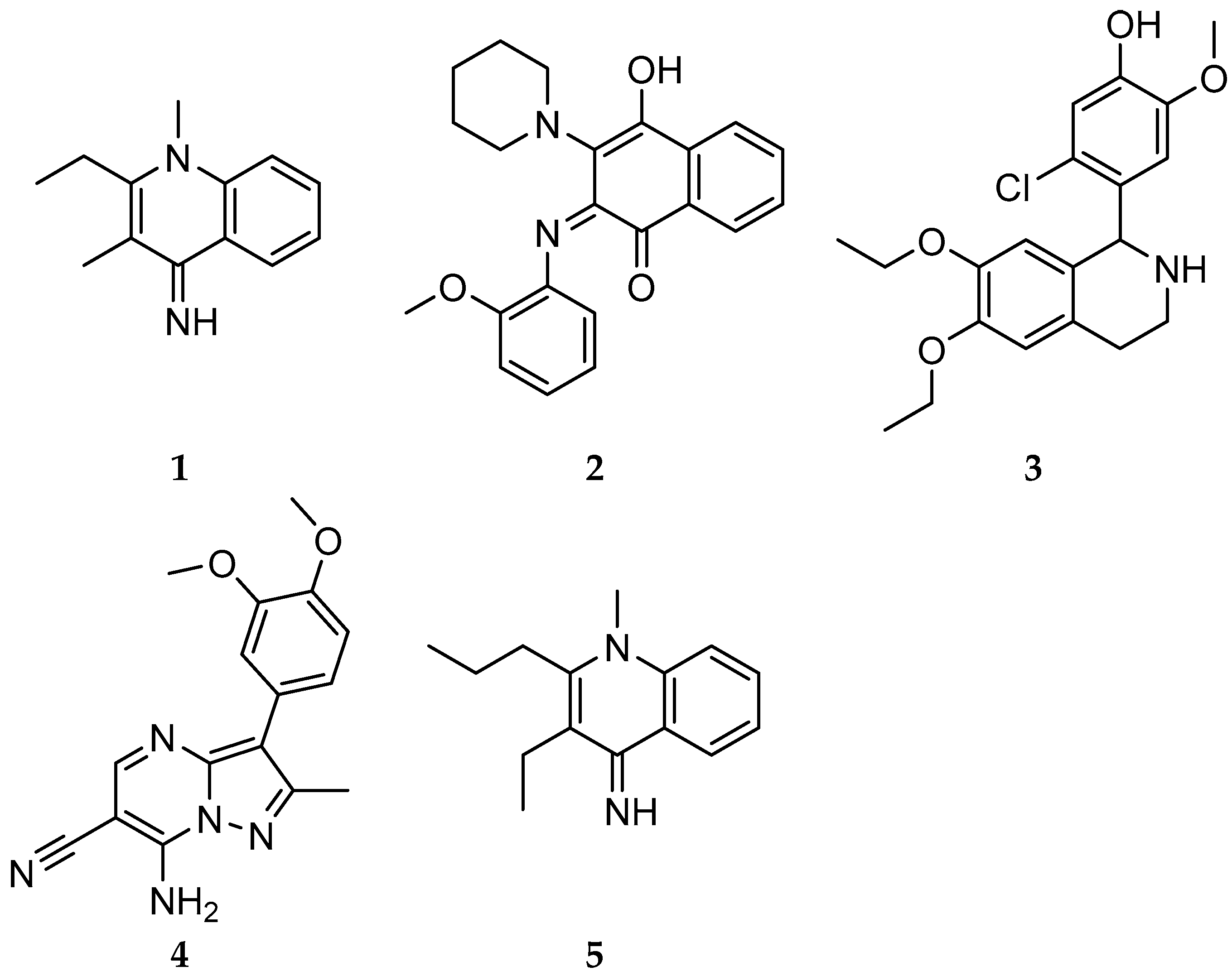Preliminary LC-MS Based Screening for Inhibitors of Plasmodium falciparum Thioredoxin Reductase (PfTrxR) among a Set of Antimalarials from the Malaria Box
Abstract
:1. Introduction
2. Results and Discussion
3. Experimental Section
3.1. Reagents
3.2. Test Compounds
3.3. LC/MS Based PfTrxR Inhibitory Activity Assay
3.4. Data Analysis
4. Conclusions
Acknowledgments
Author Contributions
Conflicts of Interest
References
- World Health Organization. World Malaria Report 2014. Available online: http://www.who.int/malaria/publications/world_malaria_report_2014/report/en/ (accessed on 5 January 2015).
- Roll Back Malaria Partnership. The Global Malaria Action Plan: For a Malaria-Free World. Available online: http://www.rbm.who.int/gmap/gmap.pdf (accessed on 15 August 2014).
- Müller, S. Thioredoxin reductase and glutathione synthesis in Plasmodium falciparum. Redox. Rep. 2003, 8, 251–255. [Google Scholar] [CrossRef] [PubMed]
- McCarty, S.E.; Schellenberger, A.; Goodwin, D.C.; Fuanta, N.R.; Tekwani, B.L.; Calderón, A.I. Plasmodium falciparum thioredoxin reductase (PfTrxR) and its role as a target for new antimalarial discovery. Molecules 2015, 20, 11459–11473. [Google Scholar] [CrossRef] [PubMed]
- Müller, S.; Gilberger, T.W.; Krnajski, Z.; Lüersen, K.; Meierjohann, S.; Walter, R.D. Thioredoxin and glutathione system of malaria parasite Plasmodium falciparum. Protoplasma 2001, 217, 43–49. [Google Scholar] [CrossRef] [PubMed]
- Nosten, F.; White, N.J. Artemisinin-based combination treatment of falciparum malaria. Am. J. Trop. Med. Hyg. 2007, 77, 181–192. [Google Scholar] [PubMed]
- Bowman, J.D.; Merino, E.F.; Brooks, C.F.; Striepen, B.; Carlier, P.R.; Cassera, M.B. Anti-apicoplast and gametocytocidal screening to identify the mechanisms of action of compounds within the Malaria Box. Antimicrob. Agents Chemother. 2013, 58, 811–819. [Google Scholar] [CrossRef] [PubMed]
- Munigunti, R.; Gathiaka, S.; Acevedo, O.; Sahu, R.; Tekwani, B.; Calderón, A.I. Characterization of PfTrxR inhibitors using antimalarial assays and in silico techniques. Chem. Cent. J. 2013, 7, 175. [Google Scholar] [CrossRef] [PubMed]
- Ehrhardt, K.; Davioud-Charvet, E.; Ke, H.; Vaidya, A.B.; Lanzer, M.; Deponte, M. The antimalarial activities of methylene blue and the 1,4-naphthoquinone 3-[4-(Trifluoromethyl)Benzyl]-menadione are not due to inhibition of the mitochondrial electron transport chain. Antimicrob. Agents Chemother. 2013, 57, 2114–2120. [Google Scholar] [CrossRef] [PubMed]
- Malaria Data. ChEMBL database. The European Bioinformatics Institute (EMBL-EBI), Cambridgeshire, UK. Available online: https://www.ebi.ac.uk/chembl/malaria/ (accessed on 11 November 2015).
- Shoichet, B.K. Interpreting Steep Dose-Response Curves in Early Inhibitor Discovery. J. Med. Chem. 2006, 49, 7274–7277. [Google Scholar] [CrossRef] [PubMed]
- Andricopulo, A.D.; Akoachere, M.B.; Krogh, R.; Nickel, C.; McLeish, M.J.; Kenyon, G.L.; Arscott, L.D.; Williams, C.H., Jr.; Davioud-Charvet, E.; Becker, K. Specific inhibitors of Plasmodium falciparum thioredoxin reductase as potential antimalarial agents. Bioorg. Med. Chem. Lett. 2006, 16, 2283–2292. [Google Scholar] [CrossRef] [PubMed]
- Theobald, A.J.; Caballero, I.; Coma, I.; Colmenarejo, G.; Cid, C.; Gamo, F.; Hibbs, M.J.; Bass, A.L.; Thomas, D.A. Discovery and biochemical characterization of Plasmodium thioredoxin reductase inhibitor from an antimalarial set. Biochemistry 2012, 51, 4764–4771. [Google Scholar] [CrossRef] [PubMed]
- Kanzok, S.M.; Schirmer, R.H.; Turbachova, I.; Iozef, R.; Becker, K. The thioredoxin system of the malaria parasite Plasmodium falciparum. J. Biol. Chem. 2000, 275, 40180–40186. [Google Scholar] [CrossRef] [PubMed]
- Bradford, M.M. A rapid and sensitive method for the quantitation of microgram quantities of proteins utilizing the principle of protein-dye binding. Anal. Biochem. 1976, 72, 248–254. [Google Scholar] [CrossRef]
- Spangenberg, T.; Burrows, J.N.; Kowalczyk, P.; McDonald, S.; Wells, T.N.C.; Willis, P. The open access Malaria Box: A drug discovery catalyst for neglected diseases. PLoS ONE 2013, 8, e62906. [Google Scholar] [CrossRef] [PubMed]
- Guiguemde, W.A.; Shelat, A.A.; Garcia-Bustos, J.F.; Diagana, T.T.; Gamo, F.J.; Guy, R.K. Global phenotypic screening for antimalarials. Chem. Biol. 2012, 19, 116–129. [Google Scholar] [CrossRef] [PubMed]
- Munigunti, R.; Calderón, A.I. Development of liquid chromatography/mass spectrometry based screening assay for PfTrxR inhibitors using relative quantitation of intact thioredoxin. Rapid Commun. Mass Spectrom. 2012, 26, 2051–2056. [Google Scholar] [CrossRef] [PubMed]
- Sample Availability: Samples of the compounds are available from MMV.


| Compound Number | MMV | IUPAC Name |
|---|---|---|
| 1 | MMV006278 | 2-ethyl-1,3-dimethylquinolin-4-imine;hydroiodide |
| 2 | MMV085203 | 2-(2-methoxyanilino)-3-piperidin-1-ylnaphthalene-1,4-dione |
| 3 | MMV008956 | 5-chloro-4-(6,7-diethoxy-1,2,3,4-tetrahydroisoquinolin-1-yl)-2-methoxyphenol |
| 4 | MMV396797 | 7-amino-3-(3,4-dimethoxyphenyl)-2-methylpyrazolo[1,5-a]pyrimidine-6-carbonitrile |
| 5 | MMV008416 | 3-ethyl-1-methyl-2-propylquinolin-4-imine;hydron;iodide |
| Test Compounds | PfTrxR IC50 (µM) | Pf(3D7) a EC50 (nM) | MRC-5 Cells b IC50 (µM) |
|---|---|---|---|
| Compound 1 | 3.5 | 378 | 41.5 |
| Compound 2 | 0.9 | 5.3 | 68.7 |
| Compound 3 | 6.6 | 370 | 85.4 |
| Compound 4 | 4.8 | 477 | >100 |
| Compound 5 | 7.5 | 242.5 | 71.2 |
| 2,4 DNPS | 0.5 | D6/W2 [8] | ND |
| Atovaquone | >10 | 0.24 [9] | ND |
| Cisplatin | ND | ND | 19.6 |
| Artemisinin | ND | 20.7 | ND |
| Chloroquine | ND | 27.3 | ND |
© 2016 by the authors. Licensee MDPI, Basel, Switzerland. This article is an open access article distributed under the terms and conditions of the Creative Commons by Attribution (CC-BY) license ( http://creativecommons.org/licenses/by/4.0/).
Share and Cite
Tiwari, N.K.; Reynolds, P.J.; Calderón, A.I. Preliminary LC-MS Based Screening for Inhibitors of Plasmodium falciparum Thioredoxin Reductase (PfTrxR) among a Set of Antimalarials from the Malaria Box. Molecules 2016, 21, 424. https://doi.org/10.3390/molecules21040424
Tiwari NK, Reynolds PJ, Calderón AI. Preliminary LC-MS Based Screening for Inhibitors of Plasmodium falciparum Thioredoxin Reductase (PfTrxR) among a Set of Antimalarials from the Malaria Box. Molecules. 2016; 21(4):424. https://doi.org/10.3390/molecules21040424
Chicago/Turabian StyleTiwari, Neil K., Priscilla J. Reynolds, and Angela I. Calderón. 2016. "Preliminary LC-MS Based Screening for Inhibitors of Plasmodium falciparum Thioredoxin Reductase (PfTrxR) among a Set of Antimalarials from the Malaria Box" Molecules 21, no. 4: 424. https://doi.org/10.3390/molecules21040424
APA StyleTiwari, N. K., Reynolds, P. J., & Calderón, A. I. (2016). Preliminary LC-MS Based Screening for Inhibitors of Plasmodium falciparum Thioredoxin Reductase (PfTrxR) among a Set of Antimalarials from the Malaria Box. Molecules, 21(4), 424. https://doi.org/10.3390/molecules21040424





